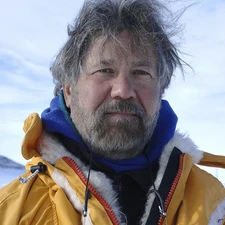Paul A. Mayewski

The 2016 Hans Oeschger Medal is awarded to Paul A. Mayewski in recognition of his outstanding contribution to ice core and climate research and his seminal contribution to ice core chemistry.
Paul Mayewski obtained his PhD in 1973 at the Institute of Polar Studies, Ohio State University. Presently he is Director of the Climate Change Institute and Distinguished Professor at the School of Earth and Climate Sciences at the University of Maine in the US. Mayewski has contributed immeasurably to both ice and climate change research. Since his first expeditions to Antarctica and the Himalaya in the early 1970s, through his leadership of major ice coring programmes in Greenland and Antarctica in the 1990s, he has been a major driving force in ice core science and palaeoclimate research. He has been a world leader in the use of ice core records to document climate change, variations in atmospheric chemistry through time, as well as the historic role of human activities on atmospheric chemistry. Among Mayewski’s numerous outstanding scientific achievements – his reference list contains more than 300 peer-reviewed papers – are the following examples: the first definitive documentation (from ice cores in Greenland) of the anthropogenic doubling of reactive nitrogen and sulfur species in the atmosphere (e.g., Mayewski et al., Science, 1986); the pioneering use of ice core chemistry as a quantitative proxy for the reconstruction of past atmospheric circulation (e.g., Mayewski et al., Science, 1994); the pioneering development of continuous-flow methods for high-resolution geochemical measurements (Osterberg et al., Environmental Sci. and Tech., 2006); some of the earliest work on glacier fluctuations in the Himalaya and early recognition of their (anthropogenic) retreat (e.g. Mayewski et al., Arctic and Alpine Research, 1980); and the recognition of the impact of changing atmospheric circulation in West Antarctica (e.g., Mayewski et al., Rev. Geophys., 2009). Paul Mayewski has made essential contributions in large international ice core projects. He was a key player (Chief Scientist) of the US GISP2 (Greenland Ice Sheet Project 2) deep ice core in central Greenland that, along with the European Greenland Ice Core Project, revolutionised our understanding of the last glacial-interglacial climatic cycle. He was instrumental in nearly all aspects of the GISP2 project, from where to drill the core, what technology to use and what critical measurements to make. He has also been the architect of the successful international ITASE (International Trans Antarctic Scientific Expedition) programme that involved more than 30 countries and has made major contributions to our understanding of Antarctic climate variability over the last 2000 years. Among the achievements of ITASE are the documentation of rapid warming in West Antarctica, the first demonstration that high-resolution radar can be used to stratigraphically link ice core records at annual timescales, the first evidence that changes in the circumpolar westerlies are probably unprecedented in the last two millennia, and the first long spatiotemporal maps of Antarctic accumulation. It is well fitting for Paul Mayewski to receive the Oeschger medal in 2016, the 20th anniversary of the final year of the GISP2 project. The discovery of Dansgaard-Oeschger events obviously belongs to Dansgaard and Oeschger, but it was Mayewsk’s leadership with GISP2 that led to the widespread understanding of their importance.
